The Cosmetics Industry Today


The Cosmetics Industry Today
28,372
"In the overall health and beauty care market, makeup margins tend to be the highest (as much as 38%), followed by skin care (as much as 35%). Hair care--satisfying the most basic beauty needs--lags at up to 33%." The markup margin for face makeup (foundation, blush, etc.) is 31%-36%, Lipstick/lip gloss is 29%-34%, and Eye makeup (liner, shadow, etc.) is 28%-33%.
In recent years, consumers have been spending higher levels of disposable income on cosmetics than they had in the past. Unfortunately, the global financial crisis has put a damper on the market and during those years, more affordably priced merchandise and do it yourself at home products were key in the beauty market. Although there are some exceptions, generally speaking, for all products the higher the household income, the higher the spending percentages. However, in recent years as Generation Y has really entered the job market, they have become a big driver of the cosmetics market in the United States. There also seems to be an increased interest in natural and organic beauty products particularly in the United States and Europe and worldwide sales were $13 billion and projected to bet $21 billion by next year according to Organic Monitor.
In the United States cosmetics are officially regulated by the Food & Drug Administration as a result of the Food, Drug and Cosmetic Act passed in 1938. There is also a self-regulatory group, Cosmetics Ingredient Review (CIR) run by the industry association – the Personal Care Products Council. In Europe the EU has cosmetics regulatory authority via EU Regulation 1223/2009 but there is also an independent group of scientists called the Scientific Committee on Consumer Safety (SCCS).
Geographically there are three countries to mention as being top consuming countries - the United States, Japan, and Brazil - though countries like China, India, Mexico and Russia are emerging as big cosmetics markets. Of the emerging economies it is Brazil, with its growing middle class and intense beauty culture, that is one of the countries that accounts for a large share of the cosmetics market outside of the United States and Asia. Cosmetics sales have been down in recent years due to the global economic crisis, but the industry is improving. Sales of nail polishes have seen a worldwide growth of 11% in 2011 and has supplanted lipstick as a barometer of the beauty industry. Prior to the global economic crisis, spending on premium brands (those sold at a significantly higher price point) were high. The numbers went down between 2007 and 2011, but in 2011 there was 5% growth in premium brands, the best since 2007. It also seems that China is making its mark in this area and sales of premium brands there has increased.
Some manufacturers like Aveda, The Body Shop, and M A C have their own stores but most products are sold in drug stores or department stores. Drug stores sell typical consumer brands like Boots, Botanics, L'Oreal, MAX Factor, Cover Girl, Maybelline, etc. Sometimes stores sell their own or an exclusive brand, such as Sonia Kashuk, sold by Target. For more "upscale" products, department stores sell from manufacturers like Clinique, Prescriptives, Lancôme, etc.



